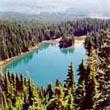|
Friday, September 22
The weather was sunny but cool as the expedition members arose. There was a steady west wind, with
some strong gusts. After breakfast, Randles offered to drive Noll into Hood River, OR, to pick up a new battery for his
vehicle. Fish accompanied them.
On their way out, Randles, Noll, and Fish decided to stop and check the roadside mud pool that Randles and Dr. Fish had placed fruit at
the night before. Some of the fruit, but not all, had been taken. Three of the original six apples were missing. Some of the melons showed evidence of
having been pecked at by birds. They noted elk, deer, coyote and bear tracks in the mud pool.
The three noticed a large impression at the eastern edge of the mud pool. It took several minutes of studying the impression before they finally
deduced that it was possibly made by a sasquatch sitting down at the edge of the pool, and leaning over to grasp the fruit in the
center. The three immediately returned to camp to inform the others.
Upon returning to camp, the trio related the details of their find to the group. Everyone gathered up all photographic equipment and casting materials
and drove out to the impression site. Noll, Randles and Fish described the scene for the others. Noll went so far as to lay down on the ground and assume the
position they believed the animal had to have been in to leave such an impression.
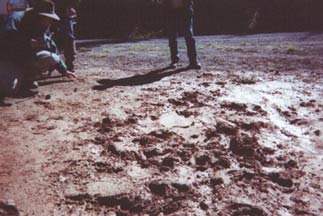
Rick Noll describes the scene to the team.
Photo by Jeff Lemley.
There were several hairs apparent in the impression, along with a few bits of chewed apple. Randles and Bambenek set about collecting these bits of evidence with sterile
tweezers, and placed them into containers for storage. Some other bits of apple were located about 15 feet away from the impression. While this was underway, several of the other participants spread out to check for any other footprints or impressions in the area.
Terry located one of the three missing apples, just beyond the embankment on the opposite side of the road from the mud pool. The apple was mostly intact, except for some peck marks from birds.
No other impressions were located in the immediate vicinity.
Several dozen pictures were taken of the impression, along with video of Noll re-enacting the suspected behavior of the sasquatch while Randles narrated and pointed to various details in the impression.
Readily apparent were the left forearm and wrist, the left buttocks and thigh, and several heel strikes. The hair patterns of the sasquatch were easily discernible in the mud.
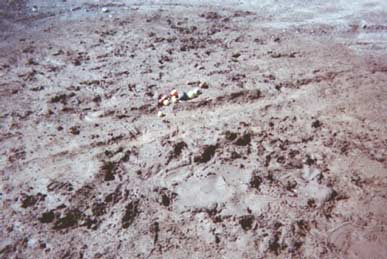
The Skookum Sasquatch Impression (click to enlarge).
Photo by Jeff Lemley.
Unfortunately, the heat from the sun, combined with a steady west wind, was quickly drying the mud pool. This quick drying began to cause cracks in the surface, including the impression. A makeshift shelter consisting of four large rocks and a
sheet of plywood was hastily erected to protect the impression from the damaging effects of the sun's rays. It was the groups concensus that the impression needed to be preserved
beyond the means provided by video and photography. Noll, who is an expert in casting materials, decided that the attempt would have to be made to cast the entire impression.
As luck would have it, Noll happened to have 50 pounds of Hydrocal B-11 casting material with him, and Fish also had a 100-pound bag of Hydrocal. This,
combined with a total of about 50 pounds in various other forms of plaster casting material, was just enough to successfully cast the entire impression. Randles was overheard commenting
that the next material to go into the casting mix was going to have to be a can of chunky stew. The group cut up some extra 2X4's that Fish had brought along to construct a camp
table, and used them to create a 42 inch by 54 inch frame around the impression. This would serve to hold the Hydrocal in place while it was hardening.
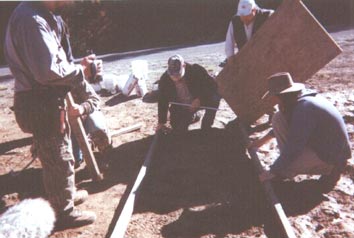
Expedition members (from left) Bambenek, Randles (behind Bambenek)
Fish, Lemley and Noll prepare the
casting forms for the impression.
Photo by Erin Lee.
Noll supervised the casting process. He was assisted by Fish and Randles. The casting was going to be a
very delicate procedure. Several coats were needed to fill in the entire impression, and extreme care had to be taken to ensure that
the material was not drying too quickly, but it had to set up to a certain extent before the next coat could be applied. Everyone in the group was assigned duties to help
smooth out the process as much as possible. Bambenek and Terry made runs to the closest creek to get water for the mix. Lemley held the plywood sheet in place to keep the sun off of the impression. Powell
continued to videotape the precedings. Lee returned to camp to
assemble a cooler full of beverages and food for the group, as the whole process from discovery through casting ended up taking several hours.
Noll foresaw the need to reinforce the cast, as the size and weight made the possibility of it breaking very high.
He ended up sacrificing the aluminium poles from his spare tent to create a cross section of reinforcement bar for the
cast. After everything was in place, the casting began. Fish and Randles proceeded with splashing a face coat onto the impression.
This is a very light, runny coat that is intended to fill in all of the cracks and
fissures in the impression, so as to obtain the most detail possible. After this coat set up, Fish and Randles, under Noll's supervision,
proceeded to poor in the first filler coat. This is a heavy, thick coat that is
intended to dry quickly, and form the core of the cast. After this coat was applied, Noll carefully placed the aluminium poles so as to
provide maximum support for the cast. More coats were applied as Noll instructed. Only Hydrocal B-11
had been used in the first few coats, until it ran out. The various plaster casting materials were then used only as a backing coat to help strengthen the cast.
These coats flaked off of the cast several days later, but not until Noll had constructed a
metal frame to safely house and display the cast.
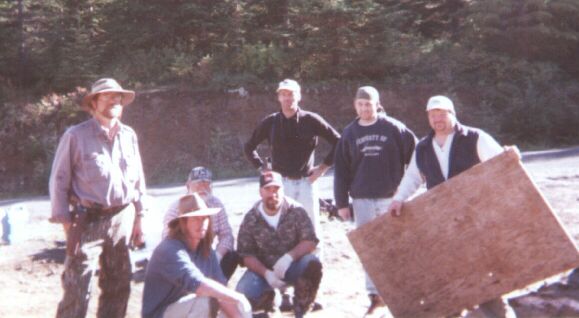
The Skookum Impression casting team finally takes a break while the cast dries.
Shown (from left) are Bambenek, Noll, Fish, Randles, Powell, Terry, & Lemley.
Photo by Erin Lee.
After the final coats were applied, the group finally had time to sit back and fully contemplate the significance of this discovery. Many high
fives and pats on the back were passed around, amidst posing for several photos. For the first time since the discovery of the impression,
some six hours previously,
members took a chance to grab a bite to eat and get something to drink. Theories were passed around as to what circumstances had led to this event,
and speculation as to what should be done with the cast was presented. Finally, Noll announced that the cast was ready to be removed from the impression.
Several members gathered around the cast and began scoring the edges of the cast adjacent to the frame so that the wood could be removed.
After the frame was gone, members then began to dig out the dirt around the edges of the cast, scooping out underneath as far as possible,
careful not to scrape the cast surface. When this was completed, Noll instructed a few people to carefully twist the cast back and forth, to help
break the suction between the cast and the ground. When he was satisfied that this had been accomplished, he directed four members to carefully lift
up on one side of the cast, until it was standing up on end. At this point, the 200 pounds of casting material and 20 gallons of water, plus the 2-3 inch thick layer of wet dirt
stuck to the face of the cast, combined to bring the weight of the cast to close to 500 pounds. The group held the cast in an upright position while
most of the dirt was brushed off of the cast, leaving only a thin layer of dirt on the cast face. This dropped the weight back down to well below 400 pounds.
The group then prepared Randles' truck for transporting the cast. Randles donated an air mattress to serve as cushioning underneath the cast, while other
members contributed whatever spare padding was available. It took 6 men on the ground plus one in the bed of the truck to successfully and safely maneuver the cast into the
truck bed. Padding was then placed around the cast to prevent it from sliding during transport. The area where the impression had been was then swept clean of all debris from the casting
procedure. Powell departed immediately after the cast was secured, as he had obligations back in Portland. Terry left as well.
After returning to camp, Randles, Fish and Noll decided to head out for Hood River again to obtain a car battery for Noll. The rest of the group remained at camp, discussing the day's discovery.
Randles, Fish and Noll returned at around 11 PM. Some more fruit and peanuts were placed at the mud wallow, in an attempt to obtain more track evidence. A combination of fatigue and high winds
won out over the remaining researchers, and so everyone retired to their tents at a relatively early hour. No vocalizations or other disturbances were noted that night.
|
.
|
|
|


